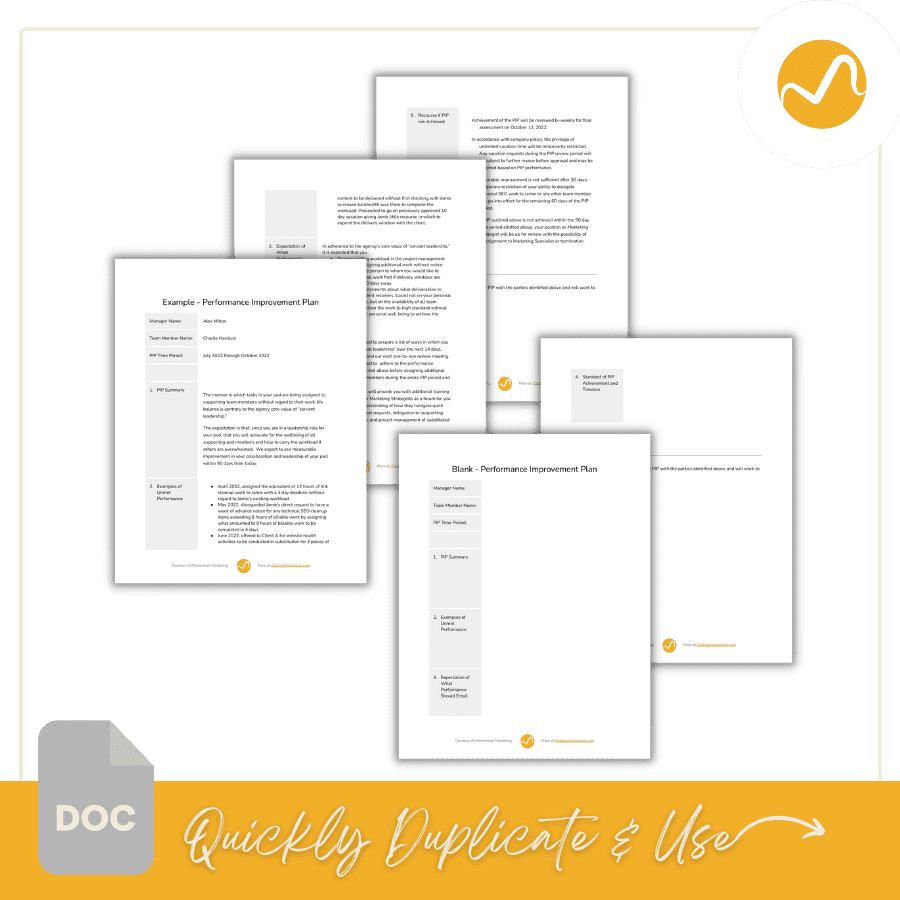Written By Danielle Fauteaux
You’ve done it. You’ve proven yourself as a leader within your marketing agency and now you are leading the team, perhaps the same team that you used to be an active contributor to. Your role has changed and now part of your regular activities will be to run effective one-on-one meetings with the team you’re leading.
What is the purpose of 1 on 1 meetings?
One-on-one meetings, aka one-to-one meetings, are regular meetings between a leader and a direct report to keep both parties informed on in progress items, issues to be resolved, and ideas to be evaluated. Separate from employee performance review meetings, one-on-one meetings should be centered around a collaborative spirit where leader and direct report alike are supporting the success of the other.
So, how do you run an effective 1-on-1 meeting?
Start by not making these seven common mistakes. In running 1-on-1 meetings at multiple different agencies and in different roles, I made these mistakes and had to learn from them and course correct. My hope is you can get yourself off to a running start by avoiding these mistakes.
Mistakes to Avoid in 1-on-1 Meetings
Mistake #1: Not having any “records of conversation” to refer back to.
Mistake #2: Using every one-on-one as a time for correction or nit-picking.
Mistake #3: Cancelling meetings last minute for “more pressing items.”
Mistake #4: Allowing team members to problem dump.
Mistake #5: Forgetting to use the time to dream.
Mistake #6: Not asking for feedback in return.
Mistake #7: Trying to be everyone’s friend. (Conversely, never being friendly).
Let’s look a bit deeper at each of these.
Mistake #1: Not having any “records of conversation” to refer back to.
I recommend having two sets of meeting notes. One set will be a transparent, dynamic file that both you and your subordinate have access to. The second is one that only you see where you can document progress or performance worries that you want to track over time and still have record of. Your “records of conversation” are different than performance improvement plans.
Mistake #2: Using the one-on-one exclusively a time for correction or nit-picking.
Even with the most difficult employees to manage, you need to restrain from making every meeting about correction or nit-picking. If you find this is occurring and you feel like you shouldn’t have hired them in the first place, you should probably proceed to helping them find a new job and letting them move on from your organization.
Mistake #3: Cancelling them last minute for “more pressing items.”
Cancelling the important because something perceived as more urgent came up is a common mistake made by managers. Often in effort to make sure they are properly spinning their 27 plates, cancelling a one-on-one causes relationship damage as a closed door surfaces, even if unintentional. You never know what your team member was going to discuss that day, and if you cancelled on them, you may never find out.
Mistake #4: Allowing team members to problem dump.
As a leader and a manager, it’s not your job to solve every big problem. It’s your role to empower and support those you lead to solve those problems. Because one-on-ones can be like debrief meetings, it’s easy for one-on-ones to turn into problem-dumping fests. Without the right expectations set forth from the very beginning about the purpose of one-on-ones, you’re setting the meetings up to be unproductive. If you find yourself, as a manager with more to do after a one-on-one than those you are leading, you need to evaluate why that is occurring.
Mistake #5: Forgetting to use the time to dream.
To build an effective team that you can rely on and trust enough to take a full 2-week vacation, your team members need to be able to see their future at the organization and take ownership over the outcomes their role relate to. To achieve this, the best managers will allocate some one-on-ones as goal setting meetings for vision casting, brainstorming, and dreaming at the individual and company level. To do this will shed light on where your team members see their value at your organization, how they would like to grow, and can even give you insight into ways you can retain these employees for longer. To be heard is a fundamental human need, and to see goodness and excitement in your future allows you to get out of bed in the morning. Especially in high stress, fast paced environments, giving time and space for team members to paint a vision of their future is critical to satisfaction, retention, and company health.
Mistake #6: Not asking for feedback in return.
Your performance as the manager is as important to keep a pulse on during one-on-ones as is the performance of the team member you are leading.
Mistake #7: Trying to be everyone’s friend. (Conversely, never being friendly).
It’s no secret that people management is one of the toughest jobs and requires extraordinary acumen and soft skills. Balancing a level of friendliness that keeps the lines of communication open and honest while ensuring you retain the authority to provide constructive correction (and it be received) is critical.
If you find yourself in the opposite camp, where it’s all business and you struggle to humanize the conversations, you can try a couple of things. I struggle with this myself, and have had to learn a few tricks to keep up my sleeve.
First, make sure you’re sitting on the same side of the table. If you’re conducting these meetings virtually, both cameras should be on at all times and you can share your screen with the record of conversations document as the focal point to set the tone for collaboration.
Next, start by sharing first. If you’re meeting early in the week, perhaps share something you did or learned over the weekend. Then ask your direct report. If they don’t share much, you can start a list when you do learn anything about them and then ask specifically about those items. You can also share about something you’re looking forward to or a funny, random thing that happened to you.
Know when it’s okay to just get down to business. With some direct reports, they will prefer to just get down to business as well. That’s okay too!
What do you discuss in a first 1-on-1 meeting?
As alluded to earlier, your first one-on-one meeting should cover the question of what team members should expect from each one-to-one – both what you will expect of them and what they can expect from you.
Especially if implementing one-on-ones is a new initiative at the agency, you want to answer any objections to the time that these one-one-one meetings are taking out of the team member’s day and assure them that these are not meant to be micro managerial meetings or constant performance reviews.
Clarify the role of each party involved:
- Lay out the foundation that your role is to encourage, support, and provide access to resources for overcoming problems.
- Point out that positive and corrective feedback can be expected (and that is should be going both ways).
- If you are good friends with a now direct report, then call out the elephant in the room and establish your authority to provide correction in the context of your agency leadership role.
- Reinforce the goal for dreams and brainstorming to occur.
You can also use the first meeting to setup your shared “record of conversation” meeting notes document.

Access a PIP Sample and PIP Template
Simply submit the form below to access a Google Doc with a complete Performance Improvement Plan Sample and a PIP Template that you can quickly duplicate and use today.
Some Questions to Ask During 1-on-1s
Especially if you have been recently promoted from being an implementer role at your agency into a position of managing team members, it can be tough to know what to ask. Here are some questions that I regularly asked during 1 on 1’s.
- “What is getting in your way?”
- “What do you need in order to succeed this week/this month?”
- “What is something you did last week/last month that you are proud of?”
- “What is something you did last week/last month that you wish you could redo?”
- “Why do you think that *negative outcome* occurred?”
- *problem shared* “Sounds like a tough situation. What is your plan of action/what are you thinking to do?”
- “What do you need from me?”
- “What are you going to do to try to prevent *problem* from occurring again in the future?”
- “What is something I could to better in my role to ensure you are successful in your role?”
- “Do you see yourself doing the same thing you’re doing currently a year from now? What do you see yourself doing 3 years from now?”
- “If you could be involved in any projects or influence any outcomes at the organization, what would that look like to you?”
In general, try to avoid asking questions that could lead to one or two word responses. You want to invite dialogue, even at the expense of efficiency because you are dealing with humans. For example, instead of asking, “Do you need anything from me?” you can ask, “What do you need from me?” This is an assuring way to provide assistance if it is needed without a team member questioning their ability to say they need help.
Remember The LAST Way
- Listen: Listen deeply to what’s being said and what isn’t being said. Remember grandma’s advice involving your two ears and your one mouth? Apply that advice here.
- Address: Address the root of the circumstance, both positive, negative, and neutral. Celebrate what needs celebrated, discuss what needs to be resolved, and identify if things seems to be rolling smoothly, without any incident in either direction.
- Solve: Solve for the present and solve for the future of your direct report’s role at the agency. Problem solve and brainstorm. This is a perspective for negative, positive, and neutral situations as well.
- Task: Clearly define the next steps following the one-to-one meeting. Define what the direct report will do next as well as anything you will be doing to support them. Your shared “record of conversation” document is where you should put these tasks in writing and with completion dates to hold each other accountable.
Know Thyself
Different leaders have different leadership styles. Different leaders also have different capacities for human interaction in a single day. Some leaders could do back to back meetings that are high touch all day long. I know one who can. I also know several who cannot, myself included.
Know how many one-to-one meetings you can effectively handle in one day, and at what time of day, in order to present your best, most engaged self to the team you are leading.

